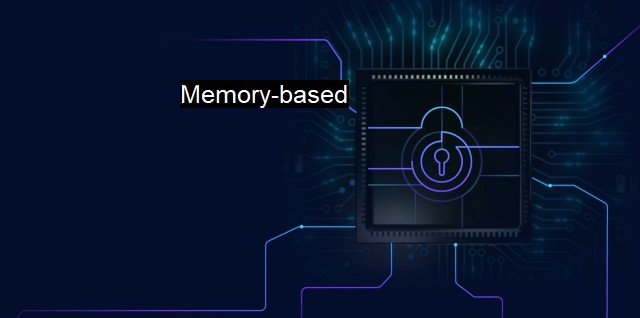What is Memory-based?
Understanding Memory-Based Attacks: A Threat to Both Businesses and Individuals
Memory-based attacks, also known as fileless or non-malware attacks, are swiftly becoming a significant threat in the field of cybersecurity. They describe a category of cyber threats wherein an attacker exploits vulnerabilities in a computer system's memory to execute malicious activities, avoiding detection by traditional file-based antivirus solutions. This intricate and unorthodox deployment of cyber warfare poses new challenges to cybersecurity personnel and antivirus software. By focusing on this analytical angle of the discussion on memory-based attacks, we can deepen our understanding of this mounting problem.At a basic, binary level, a computer program is just a series of instructions - it's when these instructions come alive, during runtime in a computer’s memory (RAM), that it becomes an application with which we interact. Traditionally, malware-based attacks centered on harmful software, or files, installed onto a computer's hard drive. These files were often disguised, hidden, or embedded into seemingly harmless pieces of software or content. Antivirus or antimalware tools would detect and remove these malicious files based on predefined signatures or heuristics, therefore protecting the host from harm.
Memory-based attacks fundamentally differ in terms of its mode of operation and undetectable traits. Such intrusions omit installing persistent copies of malware onto a system’s hard drive, hence, bypassing signature-based detection and leaving no footprints for post-incident investigation. They use allowable system tools and processes to exploit the vulnerability of an in-memory space, positioning the malicious code to be directly executed on the RAM. This makes memory-based attacks covert, ephemeral, and incredibly challenging to detect and remediate using usual security measures.
Injection of an encrypted, morphing malicious payload or camouflage in regular system operation, payload execution only when certain conditions are met and dynamic changes with updates make these sequences in memory extremely hard to identify and block from the get-go.
A key example is PowerShell-based malware, which can run sophisticated malicious scripts directly on the RAM without writing a single intrusive file to the disk. By leveraging Windows’ own administrative tool, these attacks can blend seamlessly with regular system activity, flying under the radar of most security solutions.
Equally conducive to memory-based attacks is spear-phishing, where socially engineered vulnerabilities are exploited. Attackers imitate a trusted contact and lure an employee to download and run a malicious file. The file then utilizes allowed system tools to run commands in the backgrounds and introduces malicious code into the system memory.
The inability of traditional antivirus tools to scan and protect the system memory combined with the fileless nature of these attacks eases their infiltration, justifying the shift from common file-based to memory-based attacks. These attacks need specialized behavior-based detection systems that can monitor system and network behavior, flag or isolate anomalies, or implement advanced machine learning techniques to prevent, detect and counteract such attacks.
Others include having stringent security policies, employee training, aggressive patching, router hardware change, network segmentation and use of live forensics that could help anticipate, detect, and quarantine these file-less invasions.
Memory-based attacks signal a new frontier in cyber warfare, with the current protection layers of antivirus and antimalware proving inadequate. Dealing with these threats necessitates evolving our defenses to adequately protect computer systems. It requires novel techniques and sophisticated combinations of technology including big data analytics, machine learning, and artificial intelligence, propelling cybersecurity into a new era. One that we, inevitably, must prepare for.

Memory-based FAQs
What is a memory-based attack in cybersecurity?
A memory-based attack is a type of cyber attack that exploits vulnerabilities in a computer's memory to gain access to sensitive information or to take control of the system. These attacks are becoming more common and can be difficult to detect with traditional antivirus software.How does antivirus software protect against memory-based attacks?
Antivirus software uses various techniques to protect against memory-based attacks, such as behavior-based detection, signature-based detection, and heuristics analysis. These methods can help detect and block malware before it can do serious harm to a computer or network.What are some common types of memory-based attacks?
Some common types of memory-based attacks include buffer overflow attacks, DLL injection attacks, and rootkit attacks. These attacks can be launched through various means, such as phishing emails, malicious websites, or infected software downloads.How can individuals and organizations protect themselves against memory-based attacks?
To protect against memory-based attacks, individuals and organizations should ensure that their antivirus software is up-to-date and running regular scans. They should also be cautious when downloading or opening files from unknown sources and regularly update their operating system and applications to patch any known vulnerabilities. Additionally, implementing strong password policies and multi-factor authentication can help prevent unauthorized access to sensitive information.Related Topics
Memory-based malware RAM scraping Fileless malware In-memory attacks Memory forensics
| | A | | | B | | | C | | | D | | | E | | | F | | | G | | | H | | | I | | | J | | | K | | | L | | | M | |
| | N | | | O | | | P | | | Q | | | R | | | S | | | T | | | U | | | V | | | W | | | X | | | Y | | | Z | |
| | 1 | | | 2 | | | 3 | | | 4 | | | 7 | | | 8 | | |||||||